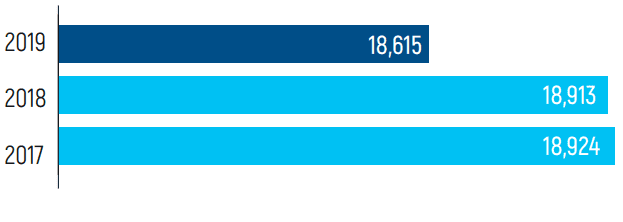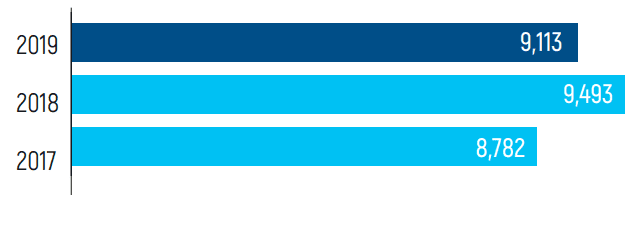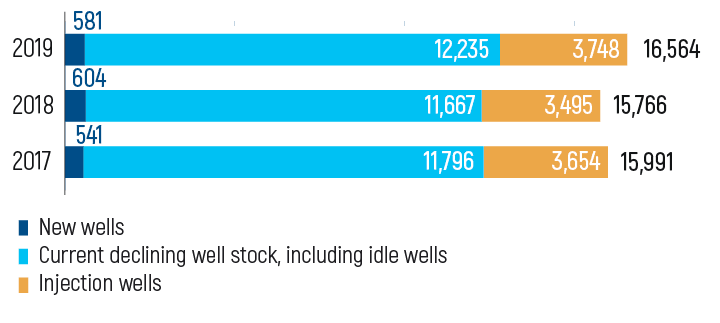Mega projects
World class projects developed in partnership with leading global integrateds.
The giant Kashagan field is the largest discovery in the last four decades and one of the most complex offshore deposits globally.
Highlights:
Oil and condensate production (total)
Oil and condensate production (net to KMG)
2P oil and condensate reserves life
Natural gas production (total)
Development perspective
Subject to final investment decisions (FIDs) for investment projects, oil production from Kashagan has the potential to reachInterests, %

Operatorship
- North Caspian Operating Company N.V.
The North Caspian project is the first major offshore oil and gas project in Kazakhstan. It includes five fields: Kashagan, Kalamkas-Sea, Kairan, Aktoty, and Kashagan South-West fields. The areas of the Kalamkas-Sea and Kashagan South-West fields are in the process of being returned to the Republic of Kazakhstan.
The giant Kashagan field is the largest oil discovery in the last four decades. The estimated 2P oil and condensate reserves life is over 120 years at the 2019 production level.
The Kashagan field lies in an offshore location 80 km from Atyrau at water depths of 3 m to 4 m. The field reservoir lies at a depth of over 4 km and is characterised by high pressures (over 700 bar) and high hydrogen sulphide (H2S) content. At the same time, sour gas reinjection at high pressures enables enhanced oil recovery.
Kashagan is one of the most challenging industry projects globally due to harsh environmental conditions at sea and significant design, logistics and safety challenges. Located in the subarctic climate, the North Caspian Sea is covered with ice for about five months a year, requiring innovative technical solutions. KMG, together with international partners, is successfully implementing the project, having achieved sustainable production rates with further growth potential.
The Kashagan field construction design comprises onshore and offshore facilities. Onshore facilities include the Bolashak Onshore Processing Facility while the offshore facilities comprise a range of artificial structures including an operational and processing complex on Island D, Island A, and early production islands EPC2, EPC3 and EPC4. A total of 40 wells were drilled on the Kashagan field, 6 of which are injection wells and 34 production wells.
The Production Sharing Agreement in respect of the North Caspian Sea (NCPSA) was signed by the Republic of Kazakhstan and an international consortium in November 1997. The operator is North Caspian Operating Company N.V. (NCOC), acting on behalf of the contractors.
Currently, KMG has a 50% interest in KMG Kashagan B.V., which in turn holds a 16.88% interest in the Kashagan mega project. The remaining 50% interest, or 8.44% in the project, is owned by Samruk-Kazyna JSC. According to the terms of the addendum to the Option Agreement between Cooperative KazMunayGas U.A.100% subsidiary of KMG, with the direct ownership of 99.7440256% and indirect ownership via KMG Kumkol LLP of 0.2559744%. and Samruk-Kazyna JSC, the option period for buying back a 8.44% interest in KMG Kashagan B.V. has been extended from 2018–2020 to 2020–2022.
| Oil production, thous. tonnes | Associated gas production, mln m3 | Sulphur production, thous. tonnes | Gas injection, mln m3 | |
|---|---|---|---|---|
| 2017 | 8,286 | 4,799 | 1,151 | 321 |
| 2018 | 13,219 | 7,697 | 1,340 | 2,235 |
| 2019 | 14,127 | 8,453 | 1,323 | 3,148 |
In 2019, for the first time in Kashagan’s history, an overhaul was successfully completed with a total shutdown of all production facilities. The repairs enabled increases in oil and gas production from onshore and offshore facilities, as well as improving the utilisation rate to 98.4%.
Oil production from the North Caspian project was 14.1 mln tonnes (307 kbopd) in 2019. Production from Kashagan peaked at around 400 kbopd in 2019, while the average daily production was 344 kbopd in Q4 2019. Associated gas production was 8.4 bln m³.
KMG’s share of oil production from the Kashagan field increased by 6.9% to 1,169 thous. tonnes of oil (25 kbopd) while associated gas production grew by 10.4% to 700 mln m³.
Under the PSA terms, all oil produced from the Kashagan field is exported, including KMG’s entitlement share of production. The key export destination is the port of Novorossiysk, to which the oil supplies are pumped via the CPC pipeline. KazTransGas JSC is the sole buyer of gas from all contractors at the Kashagan field, with whom a single gas purchase and sale contract has been signed.
Outlook for Kashagan
Once sustainable production rates are achieved, two projects are under consideration in Phase 1 to ramp up to plateau production capacity with the potential to grow oil and condensate production to 450 kbopd in the medium term.
- Bundle 1
- Raw gas supply to third party project
An FID for the projects is expected in the first half of 2020.
Bundle 1
To further ramp up oil production, KMG is considering increased raw gas reinjection and redistribution of gas to other islands through:
- upgrades to the interior parts of the two existing compressors on Island D to increase their capacity
- laying an ultra-high pressure pipeline to shift gas injection from Island D to Islands EPC2 and EPC3
- conversion of three wells on EPC islands to injection.
Commissioning of the project, subject to a positive FID, is scheduled for 2022.
Raw gas supply to third party project
North Caspian Operating Company N.V. and KazTransGas JSC are exploring raw gas supply to KazTransGas’ planned gas processing plant with an annual throughput of 1 bln m³ of raw gas per year.
Social and environmental responsibility
Under the North Caspian Sea Production Sharing Agreement, North Caspian Operating Company N.V. allocates funds annually to infrastructure and social projects in the Mangistau and Atyrau Regions. The company allocated USD 75 mln for such projects in 2019, with 11 projects successfully completed – 7 in Atyrau Region and 4 in Mangistau Region.
One of the world’s largest gas and condensate fields.
Highlights:
Production of liquid hydrocarbons (stab.A conversion factor of 0.9 is applied to total oil and condensate production to estimate stable liquid hydrocarbons. ) (total)
Liquid hydrocarbon production (stab.) (net to KMG)
Development perspective
The implementation of investment projects to maintain the achieved liquid hydrocarbon production plateau levelsgas production (total)
2P oil and condensate reserves life
Interests, %

OperatorSHIP
- Royal Dutch Shell and Eni are the joint operators of the Karachaganak field (Karachaganak Petroleum Operating B.V.)
Karachaganak oil and condensate field is one of the largest oil and condensate fields in the world, located in the West Kazakhstan Region and covering an area of over 280 sq. km. The field was discovered in 1979, with pilot development started in 1984.
The Karachaganak project is developed under the Final Production Sharing Agreement (FPSA) signed on 18 November 1997 for a period of 40 years. Equity interests in the project are as follows: Royal Dutch Shell (29.25%), Eni (29.25%), Chevron (18%), LUKOIL (13.5%), and KMG (10%). Royal Dutch Shell and Eni are the joint operators of the Karachaganak project.
The Karachaganak project has three core process facilities, comprising a single system of interrelated and interdependent process units within the Karachaganak field’s production process:
KPC – the Karachaganak Processing Complex, located in the northwestern part of the field and processing liquid hydrocarbons coming from wells as well as feedstock transported from Unit 2 with sour gas reinjection systems (Unit 2).
Core production processes:
- Stabilisation of crude oil (sulphur and mercaptan removal) for further export via the CPC pipeline system
- Treatment (dehydration) of sour gas for reinjection and export to the Orenburg Gas Processing Plant (OGPP)
- Production of treated fuel gas for own production needs of the field, for the production needs of Karachaganak Petroleum Operating B.V., and for the needs of the West Kazakhstan Region
- Wastewater treatment and disposal
Unit 2 – a gas treatment unit located in the southeastern part of the field, which separates and reinjects sour gas at high pressure and feeds liquid hydrocarbons to the KPC for stabilisation before shipment for export.
Core production processes:
- Treatment (dehydration) of sour gas for reinjection
- Reinjection of sour gas
- Transport of unstable condensate to the KPC
- Wastewater treatment and disposal
Unit 3 – a gas treatment unit located in the northeastern part of the field, which separates and partially stabilises liquid hydrocarbons and gas before shipment for export.
Core production processes:
- Treatment of gas for further export to Orenburg Processing Plant
- Condensate degassing prior to further stabilisation at the KPC
- Wastewater treatment and disposal
At the beginning of 2020, the operating well stock of the field included 156 producing wells and 18 injection wells.
Liquid hydrocarbon production from Karachaganak decreased by 7.3% to 1,015 ths tonnes (22 kbopd) in terms of KMG’s share. Gas production was 1,861 mln m³, down 1.6% year-on-year. The decrease in production was due to the complete shutdown of production facilities at the KPC, as well as Unit 2 and Unit 3 from 16 September to 10 October 2019 for scheduled preventive maintenance, which was the largest in Karachaganak Petroleum Operating B.V.’s history.
Outlook for Karachaganak
The Karachaganak oil and condensate field is in Phase 2 commercial development (Stage 2M), which includes a number of major capex projects (Production Plateau Extension Projects and the Karachaganak Expansion Project) aimed at increasing raw gas treatment and reinjection capacity to extend the duration of the liquid hydrocarbon production plateau at the achieved rates.
Karachaganak Petroleum Operating B.V.’s operational highlights






Production Plateau Extension Projects (Stage 2M):
- Installation of the additional 5th Trunk Line Project – the project will increase the annual volumeof gas injection to 10 bln m³ in order to maintain reservoir pressure.
- KPC Gas Debottlenecking Project (KGDBN) – the project envisages commissioning of new glycol gas-dehydration and low-temperature gas separation units with a total capacity of 4.0 bln m³ per year to increase the volume of gas treatment for reinjection and/or export to Orenburg Processing Plant.
- Installation of Unit 2 Fourth Injection Compressor Project (4IC) – laying a network of process pipelines to maintain reservoir pressure and the liquid hydrocarbon production plateau by increasing annual gas injection volumes from 10 bln m³ to 13 bln m³ per year.
In 2019, the 5th Trunk Line project was commissioned. In May 2019, the Consortium Partners signed an agreement sanctioning the Fourth Injection Compressor Project (4IC).
The successful timely commissioning of the 5th Trunk Line project provides confidence that Karachaganak Petroleum Operating B.V. will be able to successfully meet the expectations and deliver other major CAPEX projects currently under construction: the KPC Gas Debottlenecking Project (KGDBN) and the Unit 2 Fourth Injection Compressor Project (4IC). Commissioning of these projects is scheduled for 2021.
Combined, the production plateau extension projects will maximise the benefits through:
- increased gas treatment capacity
- incremental liquid hydrocarbon production
- upgrades to existing liquid hydrocarbon treatment units
- reduced rates of pressure declines in the reservoir.
Digital projects to transform operations
As part of the Digital Kazakhstan innovative development state programme, Karachaganak Petroleum Operating B.V. has developed a roadmap for a digital transformation and technology innovation. The current workstreams are focused on the areas of production optimisation, well surveillance, smart plant and digital transformations for project delivery, minimization of paper-intensive processes and maximisation of the automated workflows, warehouse management, improvement of the monitoring and intervention activities.
Digitizing key field parameters will enable Karachaganak Petroleum Operating B.V. to make timely decisions maximising productivity through automated integrated data analysis tools.
Social and environmental responsibility
In 2019, eight social projects were implemented in the West Kazakhstan Region, of which five were civil construction projects (mainly the construction of fitness and recreation centres) and three were road construction and repair projects.
Next-generation multiphase pumps and the Megaflow separator technology are just a few examples of the technology-driven evolution of well treatment and testing at the Karachaganak field across all three phases (gas, oil, and water). This allowed the separated hydrocarbons to be sent directly to the plant without flaring. The deployment of advanced technology and continuous improvement has enabled Karachaganak Petroleum Operating B.V. to dramatically reduce its emissions, achieving a world-class gas utilisation rate of 99.94% for Karachaganak. In 2019, total gas flaring was just 0.056% (10.4 mln m³) of the total gas produced by Karachaganak Petroleum Operating B.V. (18,614.6 mln m³).
Oil production at operating assets
At operating assets developed by KMG independently or with partners, more than half of the fields are mature given the high reserve depletion rates and increased water cuts (over 80%). Commercial development of our mature fields started many decades ago. The first oil discovery in Kazakhstan was made in 1899 at the Karashungul field, currently operated by JSC Embamunaigas. This marked the start of oil production in the country. Thus, 2019 marked 120 years of Kazakhstan’s national oil and gas industry. The first gas gusher was struck at the Uzen field in 1960, and oil gusher in 1961. The Karazhanbas gas and oil field came on stream in 1974, when the first oil gusher was struck.
Importantly, today about 80% of total oil production at the Company’s operating assets comes from seven key fields: Uzen and Karamandybas (JSC Ozenmunaigas), Kalamkas and Zhetybai (JSC Mangistaumunaigaz), S. Nurzhanov and East Moldabek (JSC Embamunaigas), and Karazhanbas (JSC Karazhanbasmunai).
Improving production efficiency at mature fields is an important driver of the Company’s future growth. To achieve this, our production facilities continuously monitor production processes to further optimise them, comply with the corporate energy-saving policy, and search for ways to increase oil recovery rates, e.g. by commissioning new wells, hydraulic fracturing, well workovers, reperforations, and polymer flooding.
In 2019, KMG’s share of oil production from operating assets decreased slightly to 15,476 thous. tonnes (307 kbopd). This reflects a natural decline in production levels at the Kazgermunai and PetroKazakhstan Inc. fields by 17.7% year-on-year and 15.5% year-on-year, respectively, which is in line with the planned production decline.
Produced oil profiles vary widely from region to region. The heaviest oil is produced at Karazhanbasmunai, with a conversion factor of 6.68 bbl per tonne. Crude oil produced at large non-operated projects is lighter, with its conversion factor close to 8 bbl per tonne.
A total of 16,564 wells were in operation in 2019, of which 12,235 were classified as the current declining well stock, which accounts for the bulk of oil and condensate production.

| Porosity | API gravity | Sulphur content, % | Number of fields | Average flow rate of new wells, tonnes per day | Average flow rate of the current declining well stock, tonnes per day | Oil conversion factor, bbl/tonne | |
|---|---|---|---|---|---|---|---|
| JSC Ozenmunaigas (100%) | 0.19 | 36.51 | 0.14 | 2 | 11.2 | 4.4 | 7.23 |
| JSC Embamunaigas (100%) | 0.27 | 32.03 | 0.62 | 33 | 11.1 | 3.8 | 7.30 |
| KazGPZ (condensate) (100%) | 0.14 | 57.05 | - | 4 | - | 0.8 | - |
| JSC Karazhanbasmunai (50%) | 0.30 | 19.81 | 1.55 | 1 | 2.9 | 2.2 | 6.68 |
| JV Kazgermunai LLP (50%) | 0.26 | 39.95 | 0.1 | 5 | 21.2 | 26.0 | 7.38 |
| PetroKazakhstan Inc. (33%) | | | | 23 | | | 7.75 |
| Amangeldy Gas LLP (condensate) (100%) | | – | 0 | 3 | 0.15 | 1.04 | – |
| JSC Mangistaumunaigaz (50%) | 0.14 | 30.77 | 0.2 | 15 | 12.7 | 6.0 | 7.23 |
| Kazakhoil Aktobe LLP (50%) | 0.10 | 36.12 | 1 | 2 | – | 17.1 | 7.50 |
| Kazakhturkmunay LLP (100%) | 0.14 | 36.12 | 3.17 | 6 | – | 32.9 | 7.21 |

